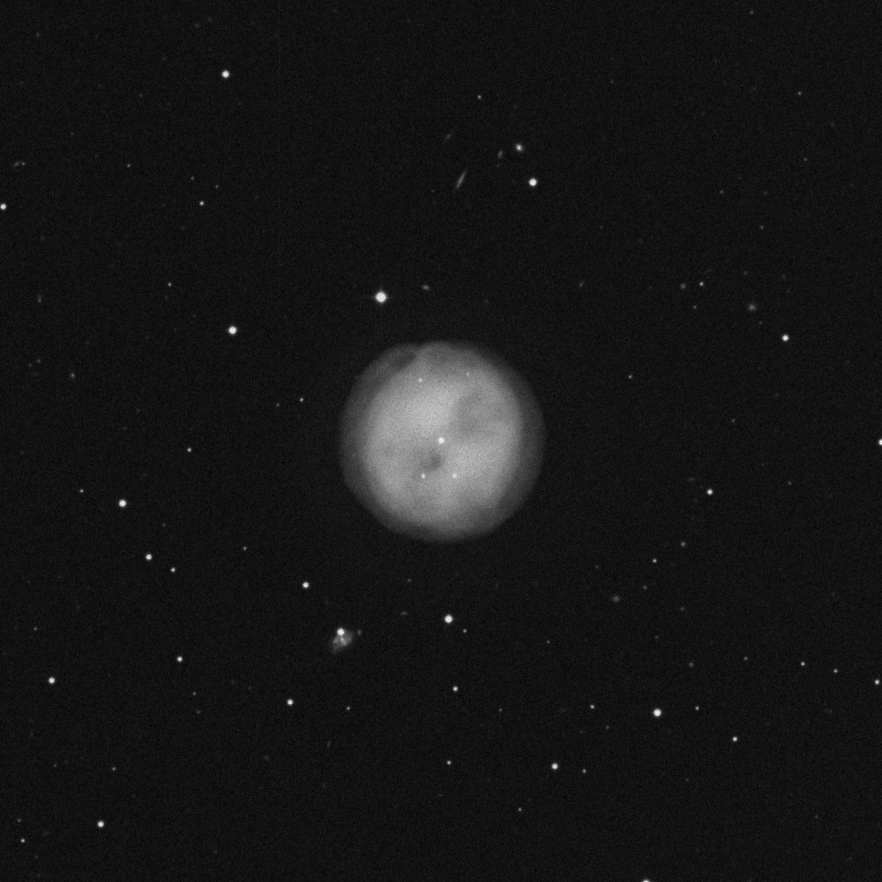Object Name: Messier 97
Alternative Designations: M97, NGC 3587, Owl Nebula
Object Type: Type 3a Planetary Nebula
Constellation: Ursa Major
Right Ascension: 11 : 14.8 (h:m)
Declination: +55 : 01 (deg:m)
Distance: 2.6 (kly)
Visual Brightness: 9.9 (mag)
Apparent Dimension: 3.4×3.3 (arc min)
Locating Messier 97: Locating Messier 97 is fairly easy. You’ll find it one third the distance in a mental line drawn between Beta and Gamma Ursa Majoris and just slightly south of that line towards a dim star. Yep. The problem isn’t finding the Owl Nebula… It’s seeing it! Despite its billed combined magnitude of 9.9, this is one low surface brightness object and requires pristine skies to be seen with an average 4″ telescope. Nebula and light pollution filters do help, but sky conditions truly dictate. (This author has seen it in 16X65 binoculars, but from a guarded dark sky site.) What you are looking for is about the same diameter that Jupiter would be in the given eyepiece you are using and under average skies will appear only as the faintest contrast change. Large aperture, fast focal ratio telescopes improve your chances marginally.
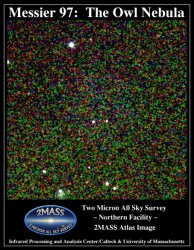 What You Are Looking At: Messier 97 is a very unusual and dynamic planetary nebula whose shape may be considered that of a cylindrical torus shell viewed on the oblique. What we see photographically (and sometimes physically) as the “Owl’s Eyes” may be the projected matter-poor ends of the cylindrical shape, while the head could be a low ionization shell. Inside this 6,000 year old denizen of the night is a dying, now 16th magnitude star with a little bit more than half the mass of our own Sun. A star which – oddly enough – can sometimes be glimpsed easier than the nebula itself!
What You Are Looking At: Messier 97 is a very unusual and dynamic planetary nebula whose shape may be considered that of a cylindrical torus shell viewed on the oblique. What we see photographically (and sometimes physically) as the “Owl’s Eyes” may be the projected matter-poor ends of the cylindrical shape, while the head could be a low ionization shell. Inside this 6,000 year old denizen of the night is a dying, now 16th magnitude star with a little bit more than half the mass of our own Sun. A star which – oddly enough – can sometimes be glimpsed easier than the nebula itself!
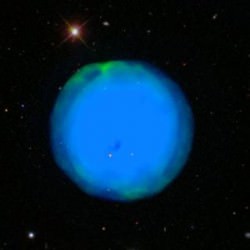 Why? Perhaps density? “We are able to evaluate the variation of excitation and electron density over the projected envelope of the source. We propose that the Owl Nebula consists of four primary shells: an internal, tilted, barrel-like component responsible for higher excitation emission; two much more uniform, spherically symmetric structures, CSCI and CSCII. These, finally, are enveloped by a much lower intensity, lower excitation halo, dubbed CSCIII. A large proportion of the low-excitation emission appears to be associated with the periphery of CSCI, and it is conceivable that this is, physically speaking, a relatively thin-shelled structure.” says L. Cuesta (et al). “[S II] density mapping appears to indicate that ne is preferentially enhanced toward the northern periphery of the shell, in a regime where low-excitation line strengths are also preferentially enhanced. We suggest that such trends may arise through northerly shocking of the shell CSC.”
Why? Perhaps density? “We are able to evaluate the variation of excitation and electron density over the projected envelope of the source. We propose that the Owl Nebula consists of four primary shells: an internal, tilted, barrel-like component responsible for higher excitation emission; two much more uniform, spherically symmetric structures, CSCI and CSCII. These, finally, are enveloped by a much lower intensity, lower excitation halo, dubbed CSCIII. A large proportion of the low-excitation emission appears to be associated with the periphery of CSCI, and it is conceivable that this is, physically speaking, a relatively thin-shelled structure.” says L. Cuesta (et al). “[S II] density mapping appears to indicate that ne is preferentially enhanced toward the northern periphery of the shell, in a regime where low-excitation line strengths are also preferentially enhanced. We suggest that such trends may arise through northerly shocking of the shell CSC.”
 So what gives with the holes we call eyes? Let’s ask R. L. M. Corradi (et al): “The haloes have been classified following the predictions of modern radiation-hydrodynamical simulations that describe the formation and evolution of ionized multiple shells and haloes around PNe. According to the models, the observed haloes have been divided into the following groups: (i) circular or slightly elliptical asymptotic giant branch (AGB) haloes, which contain the signature of the last thermal pulse on the AGB; (ii) highly asymmetrical AGB haloes; (iii) candidate recombination haloes, i.e. limb-brightened extended shells that are expected to be produced by recombination during the late post-AGB evolution, when the luminosity of the central star drops rapidly by a significant factor; (iv) uncertain cases which deserve further study for a reliable classification; (v) non-detections, i.e. PNe in which no halo is found to a level of ?10?3 the peak surface brightness of the inner nebulae.”
So what gives with the holes we call eyes? Let’s ask R. L. M. Corradi (et al): “The haloes have been classified following the predictions of modern radiation-hydrodynamical simulations that describe the formation and evolution of ionized multiple shells and haloes around PNe. According to the models, the observed haloes have been divided into the following groups: (i) circular or slightly elliptical asymptotic giant branch (AGB) haloes, which contain the signature of the last thermal pulse on the AGB; (ii) highly asymmetrical AGB haloes; (iii) candidate recombination haloes, i.e. limb-brightened extended shells that are expected to be produced by recombination during the late post-AGB evolution, when the luminosity of the central star drops rapidly by a significant factor; (iv) uncertain cases which deserve further study for a reliable classification; (v) non-detections, i.e. PNe in which no halo is found to a level of ?10?3 the peak surface brightness of the inner nebulae.”
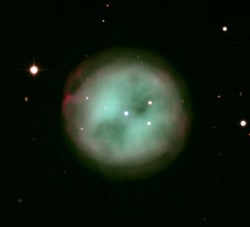 And what’s going on with the central star? “Einstein, EXOSAT, and ROSAT X-ray observations of planetary nebulae detected soft photospheric X-ray emission from their central stars, but the diffuse X-ray emission from the shocked fast stellar wind in their interiors could not be unambiguously resolved. The new generation of X-ray observatories, Chandra and XMM-Newton, have finally resolved the diffuse X-ray emission from shocked fast winds in planetary nebula interiors.” says Mart?n A. Guerrero. “Furthermore, these observatories have detected diffuse X-ray emission from bow-shocks of fast collimated outflows impinging on the nebular envelopes, and unexpected hard X-ray point-sources associated with the central stars of planetary nebulae. Here I review the results of these new X-ray observations of planetary nebulae and discuss the promise of future observations.”
And what’s going on with the central star? “Einstein, EXOSAT, and ROSAT X-ray observations of planetary nebulae detected soft photospheric X-ray emission from their central stars, but the diffuse X-ray emission from the shocked fast stellar wind in their interiors could not be unambiguously resolved. The new generation of X-ray observatories, Chandra and XMM-Newton, have finally resolved the diffuse X-ray emission from shocked fast winds in planetary nebula interiors.” says Mart?n A. Guerrero. “Furthermore, these observatories have detected diffuse X-ray emission from bow-shocks of fast collimated outflows impinging on the nebular envelopes, and unexpected hard X-ray point-sources associated with the central stars of planetary nebulae. Here I review the results of these new X-ray observations of planetary nebulae and discuss the promise of future observations.”
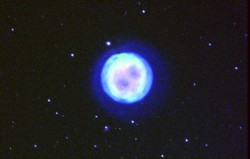 Is it possible this is just one big planetary nebula bubble? According to Adam Frank and Garrelt Mellema: “We have presented radiation-gasdynamic simulations of aspherical Planetary Nebula (PN) evolution. These simulations were constructed using the Generalized Interacting Stellar Winds scenario where a fast, tenuous outflow from the central star expands into a toroidal, slow, dense circumstellar envelope. We have demonstrated that the GISW model can produce aspherical flow patterns. In particular we have shown that by varying key initial parameters we can produce a variety of elliptical and bipolar forward shock configurations. The dependence of the shock morphology on the initial parameters conforms to the expectations of analytical models (Icke 1988). We have demonstrated that including radiation-transfer, ionization, and radiative heating and cooling does not drastically alter the global morphologies. Radiative cooling does slow the evolution of the forward shock by removing energy from the hot bubble. The evolution of the forward shock configuration is independent of the ionization of the undisturbed slow wind. Also, radiation heating and cooling does change the temperature structure of the shocked slow wind material compressed into the dense shell.”
Is it possible this is just one big planetary nebula bubble? According to Adam Frank and Garrelt Mellema: “We have presented radiation-gasdynamic simulations of aspherical Planetary Nebula (PN) evolution. These simulations were constructed using the Generalized Interacting Stellar Winds scenario where a fast, tenuous outflow from the central star expands into a toroidal, slow, dense circumstellar envelope. We have demonstrated that the GISW model can produce aspherical flow patterns. In particular we have shown that by varying key initial parameters we can produce a variety of elliptical and bipolar forward shock configurations. The dependence of the shock morphology on the initial parameters conforms to the expectations of analytical models (Icke 1988). We have demonstrated that including radiation-transfer, ionization, and radiative heating and cooling does not drastically alter the global morphologies. Radiative cooling does slow the evolution of the forward shock by removing energy from the hot bubble. The evolution of the forward shock configuration is independent of the ionization of the undisturbed slow wind. Also, radiation heating and cooling does change the temperature structure of the shocked slow wind material compressed into the dense shell.”
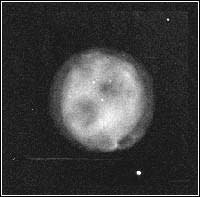 History: M97 was discovered by eagle-eyed Pierre Mechain on February 16, 1781. (That was back in the day where if you were complaining about light pollution that you asked your neighbor to “put out their candle”.) It was logged into record by Charles Messier on March 24, 1781 where he notes: “Nebula in the great Bear [Ursa Major], near Beta: It is difficult to see, reports M. Mechain, especially when one illuminates the micrometer wires: its light is faint, without a star. M. Mechain saw it the first time on Feb 16, 1781, and the position is that given by him.”
History: M97 was discovered by eagle-eyed Pierre Mechain on February 16, 1781. (That was back in the day where if you were complaining about light pollution that you asked your neighbor to “put out their candle”.) It was logged into record by Charles Messier on March 24, 1781 where he notes: “Nebula in the great Bear [Ursa Major], near Beta: It is difficult to see, reports M. Mechain, especially when one illuminates the micrometer wires: its light is faint, without a star. M. Mechain saw it the first time on Feb 16, 1781, and the position is that given by him.”
It was later noted by Sir William Herschel in his own celestial wanderings as: “The arguments that the nebulous matter is in some degree opaque which is given in the 25th article, will receive considerable support from the appearance of the following nebulae; for they are not only round, that is to say the nebulous matter of which they are composed is collected into a globular compass, but they are also of a light which is nearly of an uniform intensity except just on the borders. I give these nebulae in two assortments (incl. M97). Number 97 of the Connoissance is “A very bright, round nebula of about 3′ in diameter; it is nearly of equal light throughout, with an ill defined margin of no great extent.”
Top M97 image credit, Palomar Observatory courtesy of Caltech, M97 2MASS Image, M97 IR (NOAO), Owl Nebula – SEDS, “Owl Nebula” – Karen Kwitter (Williams College), Ron Downes (STScI), You-Hua Chu (University of Illinois) and NOAO/AURA/NSF, M97 (AANDA) and M97 images courtesy of NOAO/AURA/NSF.

